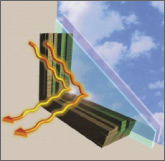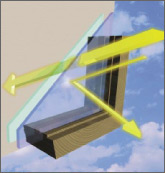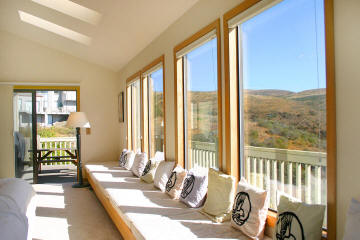A window is a glazed opening that allows daylight to enter into a
building and may be able to be opened for ventilation. Windows can be one of your home's
most attractive features. Windows provide views, daylighting, ventilation,
and solar heating in the winter. Unfortunately, they can also account for
10% to 25% of your heating bill. During the summer, your air conditioner
must work harder to cool hot air from sunny windows. Install ENERGY STAR
windows and use curtains and shade to give your air conditioner and energy
bill a break. If you live in the U.S. Sun Belt, or similar sunny regions,
look into new solar control spectrally selective windows, which can cut
the cooling load by 10% to 15%.
If your home has single-pane windows, as almost half of U.S. homes do, consider
replacing them. New doublepane custom windows with high-performance glass
(e.g., low-e or spectrally selective) are available on the market. In colder
climates, select windows that are gas filled with low emissivity (low-e)
coatings on the glass to reduce heat loss. In warmer climates, select windows
with spectrally selective coatings to reduce heat gain. If you are building
a new home, you can offset some of the cost of installing more efficient
windows because doing so allows you to buy smaller, less expensive heating
and cooling equipment.
If you decide not to replace your windows, the simpler, less costly measures
listed below can improve their performance.
Cold-climate
window tips
 |
Cold climate windows keep heat in.
Double-pane windows with low-e coating on the glass reflect heat back
into the room during the winter months.
|
 |
Warm climate windows keep heat out.
In the summertime, the sun shining through your windows heats up the
room. Windows with spectrally selective coatings on the glass reflect
some of the sunlight, keeping your rooms cooler.
|
You can use a heavy-duty, clear plastic sheet on a frame or tape
clear plastic film to the inside of your window frames during the cold
winter months. Remember, the plastic must be sealed tightly to the frame
to help reduce infiltration.
Install tight-fitting, insulating window shades on windows that feel
drafty after weatherizing.
Close your curtains and shades at night; open them during the day.
Keep windows on the south side of your house clean to let in the winter
sun.
Install exterior or interior storm windows; storm windows can reduce
heat loss through the windows by 25% to 50%. Storm windows should have
weatherstripping at all moveable joints; be made of strong, durable
materials; and have interlocking or overlapping joints. Low-e storm
windows save even more energy.
Repair and weatherize your current storm windows, if necessary.
Warm-climate window tips
Install white window shades, drapes, or blinds to reflect heat away
from the house.
Close curtains on south- and west-facing windows during the day.
Install awnings on south- and west-facing windows.
Apply sun-control or other reflective films on south-facing windows
to reduce solar gain.
$ Long-term savings tip: Installing new, high-performance windows
will improve your home's energy performance. While it may take many
years for new windows to pay off in energy savings, the benefits of
added comfort and improved aesthetics and functionality may make the
investment worth it to you. Today, many new window technologies are
available that are worth considering. Glazing materials (the glass part
of the window) now come with a variety of selective coatings and other
features; frames are available in aluminum, wood, vinyl, fiber glass,
or combinations of these materials. Each type of glazing material and
frame has advantages and disadvantages.
Shopping tips for windows
Look for the ENERGY STAR.
When you're shopping for new windows, look for the National Fenestration
Rating Council label; it means the window's performance is certified.
Remember, the lower the U-value, the better the insulation. In colder
climates, a U-value of 0.35 or below is recommended. These windows have
at least double glazing and a low-e coating.
In warm climates, where summertime heat gain is the main concern,
look for windows with double glazing and spectrally selective coatings
that reduce heat gain.
Select windows with air leakage ratings of 0.3 cubic feet per minute
or less.
In temperate climates with both heating and cooling seasons, select
windows with both low U-values and low solar heat gain coefficiency
(SHGC) to maximize energy benefits.
Remember that new windows must be installed correctly to avoid air
leaks around the frame. Look for a reputable, qualified installer.
See also window coverings
and treatments.



